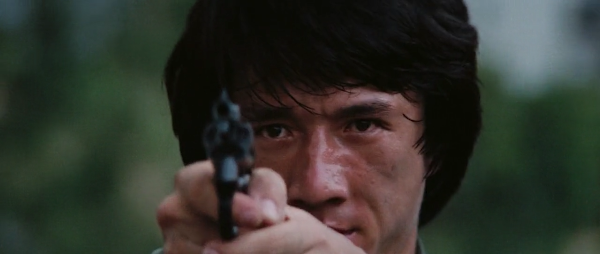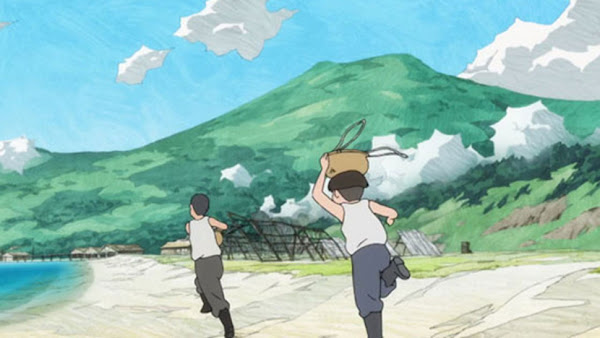Wigs vs witness: Police Story
Cyberpunk is a delightfully complex niche within the science fiction genre. In fundamentally different ways than George Lucas (thank God!), William Gibson’s writing has been indelibly influenced by Western movies and classic Japanese samurai flicks… two genres which themselves enjoy a peculiarly strong degree of overlap and mutual influence, as Druzhinin and Shal’opa satirically point out. There is a significant influence on cyberpunk, also, from the pulp fiction and trash cinema of the 60s and 70s, though it gets bent in an ironic way through the lenses of its alienated cybernetically-altered antiheroes. In Japan, cyberpunk was influenced by actual punk music videos and horror films capitalising on the growing propinquity and increasingly-invasive technological innovations. But the roots of cyberpunk lie in the classic American science-fiction works of Isaac Asimov (though Asimov’s vision of the future was considerably more optimistic) and particularly Philip K Dick. Ridley Scott’s landmark filmic adaptation of ‘Do Androids Dream of Electric Sheep?’, though, mingled Dick’s storywriting with certain æsthetic sensibilities which were borrowed from the prolific genre of Hong Kong cop movies. I’ll probably do a full-length treatment of this later, but honestly I just needed a good segue, or really just a plain excuse, to start talking about Jackie Chan’s œuvre.
Anyway, starting with one of the best: 1985’s Police Story, starring Jackie Chan, Brigitte Lin Qingxia and Maggie Cheung. Police Story is the tale of dedicated, if a bit overenthusiastic, cop Chan Ka-kui (Chan) as he tries to protect a reluctant witness for the prosecution, Selina Fong (Lin), from the retaliation of the slippery drug kingpin Chu Tu (Yuen Chor). And, this being a Jackie Chan movie, there is a jaw-dropping amount of top-quality stunt work, fight choreography (both serious and light) and slapstick comedy. Police Story has the same sort of solid, vibrant feel that a lot of 80s action movies have, with soft lenses and rail-mounted camerawork providing a weight and brilliance to the massive set-pieces and action scenes that seems to date this piece pretty closely.
When Police Story begins, Ka-kui’s unit are preparing an operation to take Chu Tu down after he pulls off a massive drug deal in an outlying Hong Kong shantytown situated on a hillside. They set up roadblocks on the hill, but the cops are detected early on and a shootout occurs in the shantytown. Ka-kui arrests Selina and cuffs her to his car, but the bad guys nearly escape in an extended chase which involves a hijacked double-decker bus on a twisty mountainside road, with Ka-kui hanging off the side. Selina is taken to the station and pressured to testify by Ka-kui’s bosses, Inspector Wong (Tung Biu) and Superintendent Lee (Lam Kwok-hung), who then assign Ka-kui to protect Selina. Ka-kui uses a comedic ruse to win Selina over, but it backfires twice – once when Ka-kui’s girlfriend Mei (Cheung) thinks he’s cheating on her, resulting in several birthday cakes to his face; and once when Selina figures out that the man who pretended to try to kill her was in fact Ka-kui’s fellow police officer. Selina then engineers a way to humiliate Ka-kui in court, and Chu Tu’s attorney Cheung (Lau Chi-wing) twists all of his testimony back on him with linguistic tricks, resulting in Chu Tu’s acquittal. Chu Tu begins making plans to frame Ka-kui for murder, using his mole inside the police force. Ka-kui goes rogue from his superiors, and Mei and Selina help him track Chu Tu down to a shopping mall, where a final showdown takes place.
Again, it is worth watching Police Story simply because it features Jackie Chan at his sublime best. The stunt work he pulls off is incredible, and is calculated for maximum effect in eliciting the awe or queasy sympathetic pain of the viewer. There’s the opening scene with the sting operation, where the mountainside shantytown gets demolished in a wild automobile chase. There’s the chase scene in the double-decker bus, with Chan being dragged behind the bus by the hook of an umbrella. There’s the rescue of Selina from Chu Tu’s villa featuring a multi-storey fall into a swimming pool by Lin or her double. And then at the end of the film there’s the jaw-dropping, balls-twisting fight sequence in the Wing On shopping mall which has Chan punishingly getting his head smashed through plate glass multiple times, thrown over a railing into a sukkot display, flung bodily down escalators, run over with a motorbike and sliding down a five-storey string of display lights. Speaking as something of a connoisseur here, both the beginning and the ending of Police Story are some of the finest martial-arts fight sequences I’ve ever watched.
Those are the stunningly-baroque bookends to the film, which in the middle mostly features the more comedic elements of Jackie Chan’s repertoire. He excels at physical comedy, and there’s plenty of it here, including the aforementioned cakes to the face. The sequence where he’s alone at the police station trying to eat noodles and juggle incoming calls on the office’s wired rotary phones (from his girlfriend trying to schedule dinner, from a DV self-report, from a man reporting a stolen cow and a woman reporting a rape) has certain cringe-inducing elements when viewed today, but the sheer elaboration of the comic routine, with Chan wheeling around in his chair getting tangled up in phone cords and finally tripping himself up over a doorjamb, is still exhilarating and technically impressive today.
Both of the female leads, Lin and Cheung, have a similarly keen knack for comic timing, and they play their lines and choreography off of Chan impeccably. The lovers’ quarrels between Ka-kui and Mei in particular involve some impressively-scripted situational humour, ad-libbing and, yes, physical comedy which calls to mind some of the better screwball comedies. And Selina herself gets her moments as well, as when she uses Ka-kui’s tape-recorder journal to play out a scenario designed to humiliate him in court. The setup and payoff for those paired sequences are brilliantly done.
The banter and wordplay here – much of it between Chan, Lin and Cheung – is excellent, but the courtroom scene with Lau in his powdered wig twisting Chan’s testimony into slinkies is a good example of why Steve Martin’s early career in philosophy led him straight to comedy. Even in English translation, the timing and delivery of the rapid-fire cross-questioning and increasingly flustered responses from Chan come across crystal-clear. That scene also solidifies the movie’s themes of proceduralism versus substantive right, and whether Hong Kong’s British-managed legal system is sufficient to deliver justice (and for whom?). The core message of the film is a populist one: you can’t depend for justice on empty forms of proceduralism and a system that is skewed toward the rich and well-connected; sometimes justice requires these acts of physical heroism and moral courage from the ‘little guy’ – in this case, Chan’s character. It’s not quite Dirty Harry or RoboCop, but it does appear to exist in a similar spiritual vein.
In fact, looking back on Police Story now after the events of 2019 and 2020, it’s tempting to see in Chan’s signature work (and the one he’s still most proud of) the seeds of his current attitudes vis-à-vis Hong Kong’s police, government and complex situation with the mainland. His focus was never on formal legal abstractions, but on the substantive issues underlying them, and this was the case even in Police Story: it makes sense that, when the protesters are siding with a psycho who murdered his pregnant girlfriend, he would take the side of the police and the government that sought to see a more tangible form of justice done. To Western eyes it may appear as something of a rôle reversal from Ka-kui’s lone cop on the edge approach, but the basic contours of the underlying logic appear to be the same.
But the reasons that Police Story is still the work that Chan is most proud of, however, are fairly plain to see from the execution of the film alone. It showcases a great breadth of Chan’s repertoire and clearly stretches him to the limits of his physical capabilities as a martial artist, and the point appears to be the sheer spectacle of some of the scenes he exhibits. This is film before the age of CGI – no green screens, very little editing done. As is usual with Jackie Chan films, there is an outtakes reel at the end, which features lengthy segments showing the choreographic setups, mattress placement and safety precautions which Chan and the other martial artists and stuntmen in Police Story had to take as they were filming. These outtake reels actually add to the sense of awe one feels at seeing this film, and the conviction that these are people who live and cheat death by their craft.
It’s very much worth going back and watching the first Police Story even after all these years. From literally any perspective, it’s still an exemplar of 80s action-film technique and craft, and whether you approach it for comedic or technical enjoyment of the martial arts, it holds up as a classic in the Hong Kong police film genre.








Comments
Post a Comment